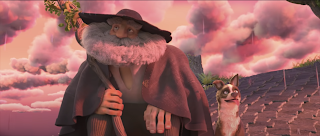A shepherd lives alone in a secluded valley, accompanied only by his flock of sheep and his loyal dog. The shepherd has a remarkable ability: he shears the sheep and creates clouds with the wool, which rain upon the valley, keeping it verdant and fruitful with plants and nature.
But when the shepherd passes away, the valley begins to become barren, and the sheep are in desperate need of shearing. The dog must find a way to continue the shepherd’s work — or risk the decimation of his home.
Created by students from the French animation school MoPA — Valerian Desterne, Juan Olarte Zuniga, Carlos Osmar Salazar Tornero, Lucile Palomino, Juan Pablo de la Rosa Zalamea, Celine Collin and Rebecca Black — this wise, gentle animated short uses its serene, whimsical visuals, storytelling clarity and an impeccable score to weave a beautiful parable about nature, balance, loyalty and legacy.
It charms the eyes and ears with its soft, rounded shapes and beautifully clear colors, rendering both characters and settings with sensitivity, grace and keen attention to detail and gesture to communicate emotion.
Whether it’s in how the shepherd pets the dog or how the canine wags its tails, the love between the pair is well-worn and palpable, as is the dog’s grief and bewilderment when the shepherd passes on. Yet there’s also soft, good-spirited humor to be found, as when the sheep puff up with their exuberantly overgrown wool.
And like the best of animation, which uses its ability to imagine anything to create magic beyond realism, there’s also a lovely sense of surprise and delight in its flights of fancy, as when viewers watch wool become life-giving clouds, with a whimsical lightness and buoyancy.
But it also doesn’t shy away from the problems and dilemmas found even in this little corner of paradise, and when it becomes clear that the dog must find a way to continue his master’s work.
“After the Rain” really excels with its storytelling, and though its running time is less than nine minutes, it possesses the profundity, wit and wisdom of much larger narratives. Like many great stories of children’s literature, it taps into the archetypal and symbolic, using universal emotions and dilemmas in service of moral and emotional clarity.
Using charm, humor and a sense of pastoral innocence, “After the Rain” gently teaches a lesson about the interconnection of nature, as well as the way we honor a loved one’s legacy and meaningful commitments. It places living beings with agency and the ability to act as a crucial part of the larger ecosystem, and in a way, implies that we are all shepherds looking after nature, picking up and continuing the work and responsibilities of the good spirits before us.







